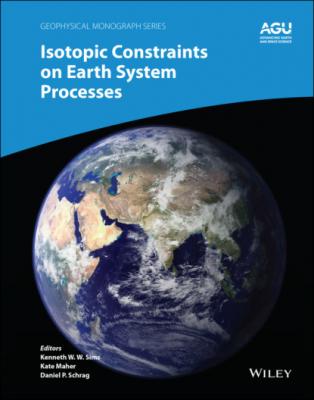Isotopic Constraints on Earth System Processes. Группа авторов
Чтение книги онлайн.
Читать онлайн книгу Isotopic Constraints on Earth System Processes - Группа авторов страница 34
 the initial concentration contrast is very small, as is the case for CaO. Another peculiarity of this system is the extremely fast diffusion of K2O, which appears to be largely decoupled from that of SiO2. This bears similarities to the behavior of Li2O in the basalt‐rhyolite experiments of Richter et al. (2003), but unlike Li2O, K2O is a major component, and because of requirements for mass and charge balance, its diffusion influences the profiles of all the other major elements either by dilution, enrichment, or diffusive coupling. Not only does K2O diffuse rapidly, but it also exhibits large diffusive isotope effects despite there being only a 2 amu difference between 41K and 39K. In following sections, we adapt an existing framework that enables us to model the SiO2, CaO, and K2O profiles and to quantify the mass dependence on diffusion coefficients in order to place the phonolite‐rhyolite results in the context of previous studies.
the initial concentration contrast is very small, as is the case for CaO. Another peculiarity of this system is the extremely fast diffusion of K2O, which appears to be largely decoupled from that of SiO2. This bears similarities to the behavior of Li2O in the basalt‐rhyolite experiments of Richter et al. (2003), but unlike Li2O, K2O is a major component, and because of requirements for mass and charge balance, its diffusion influences the profiles of all the other major elements either by dilution, enrichment, or diffusive coupling. Not only does K2O diffuse rapidly, but it also exhibits large diffusive isotope effects despite there being only a 2 amu difference between 41K and 39K. In following sections, we adapt an existing framework that enables us to model the SiO2, CaO, and K2O profiles and to quantify the mass dependence on diffusion coefficients in order to place the phonolite‐rhyolite results in the context of previous studies.
2.5. MODELING
There are two classes of diffusion models that can explain complicated diffusion behavior in a multicomponent system. The first is a more general multicomponent diffusion model that invokes a matrix of diffusion coefficients (Onsager, 1945). The second is a form of effective binary diffusion model in which components diffuse in response to activity gradients, which in turn are given by the concentration of SiO2 (Richter, 1993; Zhang, 1993).
2.5.1. General Multicomponent Diffusion
In a multi‐component system, the diffusive flux Ji (moles m2/s) of component i is given by:
(2.3)
where Dik (m2/s) is the multicomponent diffusion matrix and Ck is the concentration of component k in volume‐normalized units. The off‐diagonal terms in the diffusion matrix represent diffusive coupling between components, which may be kinetic (the diffusing species have a stoichiometry that differs from the stoichiometry of the chosen components of the system) or thermodynamic (the flux of one component influences the activity or concentration of another). The full diffusion matrix has been determined for only a few simplified silicate liquid systems (Chakraborty et al., 1995; Kress & Ghiorso, 1993; Liang, 2010; Liang & Davis, 2002; Liang et al., 1996; Mungall et al., 1998; Oishi et al., 1982; Richter et al., 1998; Sugawara et al., 1977; Wakabayashi & Oishi, 1978; Watkins et al., 2014) as well as some basaltic liquids (Guo & Zhang, 2016, 2018; Kress & Ghiorso, 1995). The full diffusion matrix is not known for either phonolite or rhyolite. Even if it were known, it would be composition dependent in the mixing region between the two liquids, and at present there is no general way of dealing with such a complex diffusion problem. Therefore, it is not practical to use a multicomponent diffusion model for describing the fluxes in the rhyolite‐phonlite diffusion couple, and a simplified approach must be employed.
2.5.2. The Zhang (1993) Modified Effective Binary Diffusion Model
The effective binary diffusion (EBD) model (Cooper, 1968) is often used in applications where the goal is to infer timescales of magmatic processes in complex systems (cf. Zhang, 2010). In this framework, the flux of component i is proportional to its own concentration gradient:
(2.4)
where Di EBD is the effective binary diffusion coefficient (EBDC) and is sensitive to melt composition and the direction of diffusion in composition space (Liang, 2010; Zhang, 2010).
There are a number of shortcomings of the EBD model, but the main one for our purposes is that it cannot describe uphill diffusion. This led Zhang (1993) to propose a modified EBD model based on the concept of elemental partitioning between two liquids of different composition. The Zhang model treats the diffusive flux of a component as being proportional to an activity gradient instead of a concentration gradient (following Zhang’s notation, we drop the subscript i to make the expressions easier to read):
where γ is the activity coefficient and
where C− and C+ are the initial concentrations at x < 0 and x > 0 for the diffusion couple and Cf is the difference in the equilibrium concentration between the two liquids, as depicted in Fig. 2.5. The parameter Cf can be positive or negative, depending on whether the component preferentially partitions into the high‐silica or low‐silica liquid. A large Cf implies strong preference for one liquid versus the other. If Cf = 0, the model reverts back to the simplified EBD model. Replacing γ with 1/Ce in equation 2.5 yields